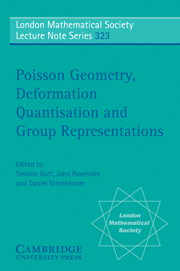Book contents
- Frontmatter
- Contents
- Preface
- Part One Poisson geometry and morita equivalence
- 1 Introduction
- 2 Poisson geometry and some generalizations
- 3 Algebraic Morita equivalence
- 4 Geometric Morita equivalence
- 5 Geometric representation equivalence
- Bibliography
- Part Two Formality and star products
- Part Three Lie groupoids, sheaves and cohomology
- Part Four Geometric methods in representation theory
- Part Five Deformation theory: a powerful tool in physics modelling
- Index
4 - Geometric Morita equivalence
Published online by Cambridge University Press: 04 August 2010
- Frontmatter
- Contents
- Preface
- Part One Poisson geometry and morita equivalence
- 1 Introduction
- 2 Poisson geometry and some generalizations
- 3 Algebraic Morita equivalence
- 4 Geometric Morita equivalence
- 5 Geometric representation equivalence
- Bibliography
- Part Two Formality and star products
- Part Three Lie groupoids, sheaves and cohomology
- Part Four Geometric methods in representation theory
- Part Five Deformation theory: a powerful tool in physics modelling
- Index
Summary
In this chapter, we introduce a purely geometric notion of Morita equivalence of Poisson manifolds. This notion leads inevitably to the consideration of Morita equivalence of symplectic groupoids, so we will make a digression into the Morita theory of general Lie groups and groupoids. We end the chapter with a discussion of gauge equivalence, a geometric equivalence which is close to Morita equivalence, but is also related to the algebraic Morita equivalence of star products, as discussed in Section 3.3.
Representations and tensor product
In order to define Morita equivalence in Poisson geometry, we need notions of “representations” of (or “modules” over) Poisson manifolds as well as their tensor products.
As we saw in Example 2.24, symplectic manifolds are in some sense “irreducible” among Poisson manifolds. If one thinks of Poisson manifolds as algebras, then symplectic manifolds could be thought of as “matrix algebras. Following this analogy, a representation of a Poisson manifold P should be a symplectic manifold S together with a Poisson map J : S → P which is complete. At the level of functions, we have a “representation” of C∞(P) by J* : C8(P) → C∞(S). This notion of representation is also suggested by the theory of geometric quantization, in which symplectic manifolds become “vector spaces” on which their Poisson algebras “act asymptotically”.
More precisely, we define a left [right] P-module to be a complete [anti-] symplectic realization J : S → P. Our first example illustrates how modules over Lie-Poisson manifolds are related to hamiltonian actions.
- Type
- Chapter
- Information
- Publisher: Cambridge University PressPrint publication year: 2005

